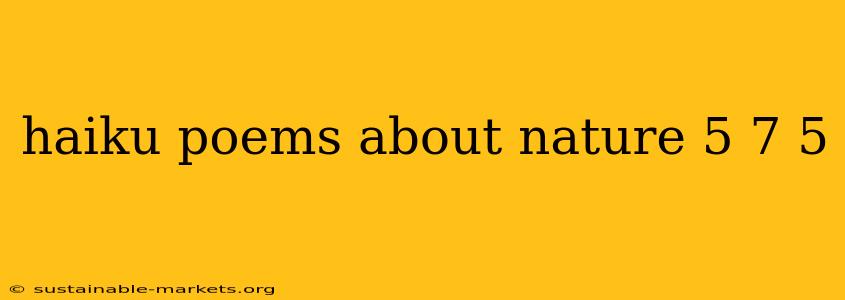Haiku Poems About Nature: A Deep Dive into 5-7-5 Syllable Structure
Haiku, the deceptively simple Japanese poetic form, often evokes powerful imagery with its concise structure. While the traditional 5-7-5 syllable count is a common understanding, the essence of haiku lies in capturing a fleeting moment in nature, often involving a juxtaposition of images or ideas. This post explores the beauty and artistry of nature-themed haiku, delving deeper than a simple list to offer insight into the form and its application.
Understanding the 5-7-5 Syllable Structure
The 5-7-5 syllable structure is a widely accepted guideline, yet modern interpretations often deviate slightly, prioritizing the overall rhythm and feeling over strict adherence to the count. The emphasis should always be on capturing the kireji—the "cutting word"—a pause or break that creates a subtle shift in the poem's meaning.
Examples of Nature Haiku: Exploring the Nuances
Let's delve into several haiku examples, analyzing their structure and the evocative imagery they create:
1. Mountain Majesty:
Silent mountain peak, Clouds drift lazily above, Nature's quiet peace.
This haiku follows the 5-7-5 structure precisely. The imagery is clear and evokes a sense of serenity. The kireji is implied by the shift from the static mountain to the moving clouds.
2. Ocean's Embrace:
Waves crash on the shore, Seagulls cry, a lonely sound, Salty air blows free.
Again, this example adheres to the 5-7-5 structure. The vivid imagery and onomatopoeia ("crash") amplify the sensory experience. The loneliness of the seagull's cry contrasts with the freedom of the salty air, adding depth.
3. Forest's Whisper:
Sunlight filters down, Through leaves, a gentle green hush, Life breathes softly here.
This haiku subtly shifts the focus from visual imagery to auditory and tactile sensations. The "gentle green hush" is particularly evocative. The final line subtly emphasizes the life force of the forest.
4. Autumn's Embrace:
Crimson leaves descend, A gentle breeze carries them, Winter slumber nears.
This haiku uses seasonal imagery to great effect, highlighting the transition from autumn to winter. The action of the falling leaves and the gentle breeze creates a sense of movement and impending change.
5. Spring's Awakening:
First buds unfurl slow, Sunlight warms the sleepy earth, New life starts anew.
This haiku, with its emphasis on new life, uses simple words to create a feeling of renewal and hope. The slow unfolding of the buds mirrors the gradual awakening of nature itself.
Beyond the Numbers: The Essence of Haiku
While the 5-7-5 structure serves as a helpful guide, the true power of haiku lies in its ability to capture a single, poignant moment in nature using carefully chosen words. It’s about economy of language, precise imagery, and a profound understanding of the subject. The focus shouldn’t solely be on the numerical structure but on the emotional resonance and artistic impact of the poem.
This exploration demonstrates the versatility and depth of haiku, a poetic form capable of expressing profound ideas within a remarkably compact structure. The examples provided aim to inspire further exploration and creativity in the art of writing haiku about the natural world.

